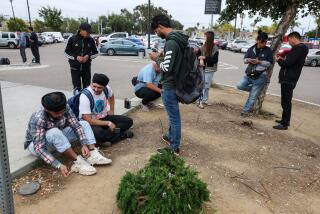Area Codes for Devices Approved
- Share via
The Federal Communications Commission on Wednesday approved the creation of two special area codes in California for ATMs, cash registers and multi-line fax machines -- a move expected to ease the shortage of phone numbers in existing area codes.
The move comes as state regulators are set to decide today whether to overlay the 310 area code with a new area code, and as five other area codes, including the San Fernando Valley’s 818, Orange County’s 714 and San Francisco’s 415, are facing a critical shortage of numbers.
Opponents of the 310 overlay said they planned to ask the Public Utilities Commission to delay a vote on the matter until officials could determine the effect of the two new area codes.
Until now, the PUC appeared to be leaning toward approving a plan supported by the phone carriers that would have virtually all new numbers issued in the 310 territory given a new area code, 424.
Supporters of the overlay said they hoped the PUC would still approve the measure but acknowledged a delay was possible.
The phone industry has blamed the shortage of numbers on the proliferation of business technologies that require phone lines. These devices include credit card scanners as well as Voice Over Internet Protocol services -- with which users can make phone calls routed through the Internet -- and vehicle response systems such as OnStar, which allow drivers to make emergency phone calls from their car to operators.
The decision by the FCC gives California permission to create two area codes designated as “technology-specific or specialized overlays” -- one for Northern California, the other for Southern California. These area codes would be used exclusively for these types of applications.
Community leaders in the South Bay and Westside -- which have fought for years to avoid changing the 310 -- cheered the FCC decision, saying they had long urged a special area code for business devices.
“This has the potential ... [to] free up many many numbers, hundreds of thousands of numbers,” said Jacki Bacharach of the South Bay Cities Council of Governments. “It’s something we’ve been asking for, and it would greatly affect the number of available numbers in the 310 area code.”
Added Redondo Beach Councilman John Parsons: “It’s been a long time coming. It’s something I think will be significant for the 310 area code and for other area codes around the country.”
The FCC has been discussing business device overlays for years, but this appears to be the first time the government has allowed one.
Connecticut has also applied for such an overlay.
The FCC experimented with an exclusive area code for cellphones in New York City in the 1990s but abandoned the idea for other areas after cellphone companies said they wanted the same area codes as land lines.
The 310 code extends from Malibu to the Palos Verdes Peninsula, and to Beverly Hills, Torrance and most of Inglewood.
Phone carriers said that regardless of the FCC’s decision, the shortage of phone numbers in the 310 area was dire and that the PUC should move forward with the 424 overlay.
“The 310 itself is very close to exhaustion, and there needs to be action right now,” said Michael Bagley, executive director for public policy for Verizon Wireless. “The PUC has gone through the data of looking at the area codes, and we believe they should vote.”
Bagley said because the idea of a technology-specific overlay was so new, it was not immediately clear whether it would provide substantial relief for the 310 area code, which he said was nearly out of phone numbers.
“This proposal, we found out about it today, and I don’t think anyone has had a chance to study it in great detail,” said Bagley, who also questioned the timing of the FCC decision, coming just one day before the PUC meeting.
“They picked the day before the vote to make the decision, which might seem politically motivated,” he said.
PUC spokeswoman Terrie Prosper said late Wednesday that the commission still planned to take up the overlay issue today.
For years, residents and businesses in the 310 area code have battled requests by phone carriers to add an area code, saying that there are conservation measures to extend the life of the area code.
Phone carriers said that conservation measures that had been instituted in recent years had worked, but the growing appetite for phone numbers by cellphone users, ATMs and credit card machines had nearly exhausted the remaining supply.
For a while, officials considered splitting the 310 in two: giving the 424 to the South Bay and letting the Westside keep 310. A big complaint of the current overlay plan is that it would require dialing 11 digits to make a phone call in the region: “1,” plus the area code and the seven-digit phone number.







